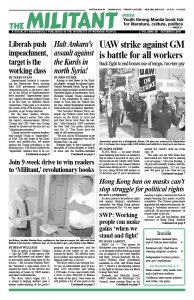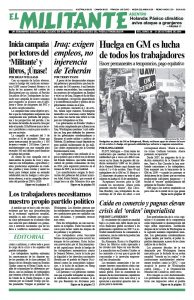Aiming to deal blows to the Kurdish peoples’ struggle for national rights, Turkish President Recep Tayyip Erdogan has begun airstrikes on the Kurdish-controlled region of northeastern Syria. President Donald Trump announced Oct. 6 the withdrawal of some U.S. troops in Syria near the Turkish border area, stating Washington would not stand in the way of Ankara’s operation.
“The Socialist Workers Party demands the Turkish rulers halt their attacks on the Kurds in Syria and pull their forces back from the border,” Seth Galinsky, SWP candidate for New York City public advocate, said Oct. 9. “The Kurds have the right to self-determination.
“We also call for Washington to get all its troops and weaponry out of the Middle East,” he said.
Erdogan plans to force hundreds of thousands of Syrian refugees in Turkey to move into the Kurdish-controlled area of northeastern Syria once his military occupies it. He hopes this “Arabization” would separate Kurds in Turkey from their brothers and sisters across the border in Syria and create a base of support to thwart the Kurds’ struggle for self-determination.
Turkish government forces launched airstrikes on Kurdish fighters in Ras al-Ain and other Syrian border villages Oct. 9, three days after a phone call between Trump and Erdogan.
Some 30 million Kurds are an oppressed nationality spread across Iran, Iraq, Syria and Turkey. Over decades the capitalist rulers there suppressed Kurds’ struggle for rights and a homeland, with the complicity of Washington and other imperialist powers. The U.S. rulers have turned support for the Kurds on and off, as best serves their imperialist interests.
After millions of working people joined an uprising against the Bashar al-Assad dictatorship in Syria in 2011, Kurds were able to carve out an autonomous area. That region expanded as the Kurdish-led Syrian Democratic Forces helped lead the ground efforts to defeat the reactionary “caliphate” of Islamic State. This area now covers some 25% of the country, including most of its oil. The Turkish rulers see the Kurdish-controlled area of Syria as a threat to their efforts to repress Kurds in Turkey, who are also fighting for their national rights.
While Trump says he wants “to get out of these ridiculous, endless wars … and bring our soldiers home,” his administration’s measures amount to moving an estimated 50 U.S. special operations troops out of two border outposts.
Facing bipartisan criticism in Congress that he was abandoning a U.S. “ally,” Trump said he had no intention of abandoning the Kurds and threatened to “obliterate the Economy of Turkey” if Ankara’s forces did anything he deemed “off limits.” None of the 1,000 troops the U.S. rulers deploy in northeastern Syria have been told to leave and most still remain in areas controlled by the Syrian Democratic Forces.
Washington has been engaged in a series of disputes with Ankara, its fellow NATO member, including opposition to the Turkish regime’s decision to accept an anti-missile system from Moscow.
In response to the Turkish government’s threat to push back and punish Syrian Kurds, commanders of the Kurdish People’s Protection Units (YPG) ordered their forces closer to the Turkish border.
Kurdish regional officials are seeking protection from the Syrian and possibly even the Russian government “to fill the void,” they say, if U.S. forces depart. But like Washington, both Damascus and Moscow have long records against the Kurds’ fight for national rights. Assad says he wants to seize control of northeast Syria back from the Kurds.

